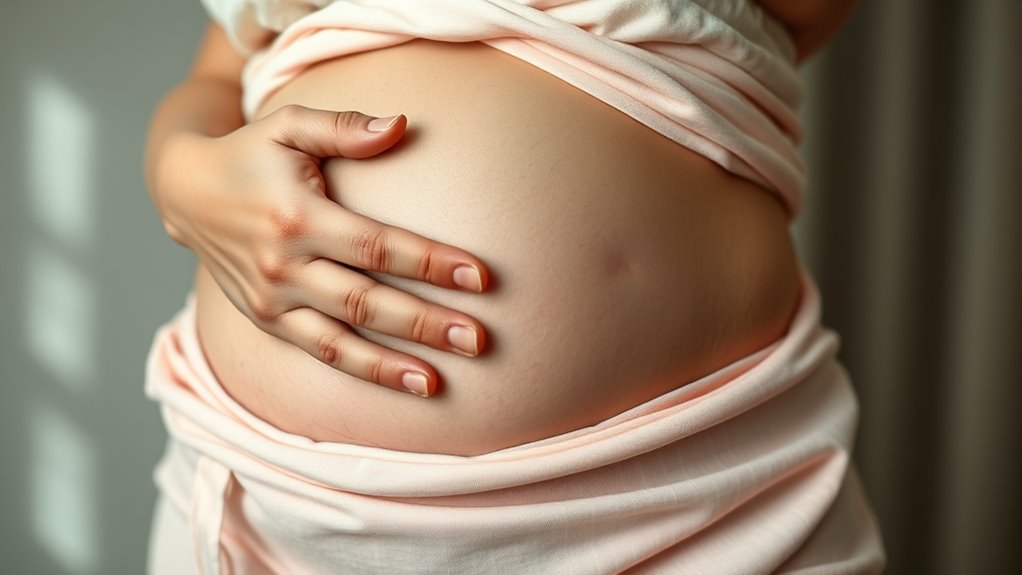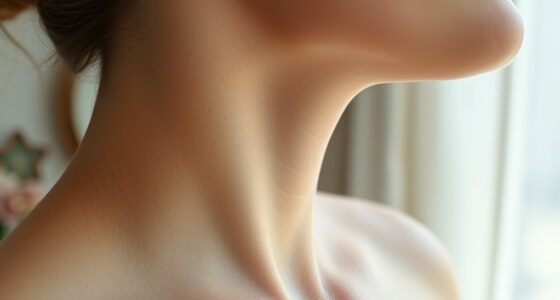To identify postpartum hernias early, look for persistent pressure, bulges that enlarge with activity, or sharp pain near your incision or abdominal wall. Notice if swelling feels firm, includes redness, or worsens over time, especially after coughing or lifting. Pay attention to any discomfort that doesn’t improve and seems to grow or become more painful. Being aware of these signs can help you seek timely medical care—more tips to recognize these changes are just ahead.
Key Takeaways
- Look for a noticeable bulge or swelling in the groin, abdomen, or near the incision that worsens with standing or strain.
- Watch for persistent, localized pain that increases with movement, coughing, or lifting.
- Monitor for changes in hernia size, firmness, or protrusion, especially after physical activity or straining.
- Recognize symptoms like dull ache, heaviness, or burning sensations near the hernia site.
- Seek medical evaluation if swelling, pain, redness, or signs of complications like fever or enlarging hernia occur.
Recognizing Common Discomforts That May Signal a Hernia
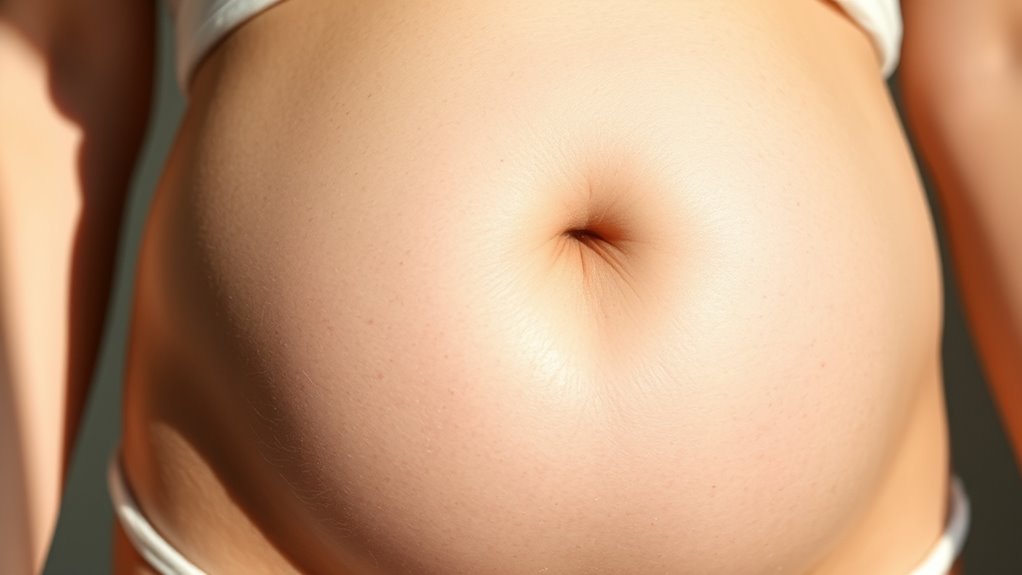
After giving birth, it’s important to pay attention to certain discomforts that could indicate a hernia. You might notice a persistent feeling of pressure or heaviness in your abdomen or groin area. Some women feel a dull ache or a burning sensation that doesn’t go away. You could also experience a noticeable bulge or swelling that appears when you stand or strain and sometimes disappears when you lie down. These discomforts often develop gradually but can become more bothersome over time. Recognizing these early signs helps you seek medical advice promptly. While not all discomforts mean a hernia, being aware of these common sensations ensures you don’t ignore potential warning signs. Paying attention to your body postpartum is essential for your health. Additionally, understanding the impact of postpartum hernias can aid in early detection and intervention.
Symptoms to Watch for in the Abdominal Area

Pay close attention to specific symptoms in your abdominal area, as they can signal a hernia. You might notice a bulge or swelling that becomes more prominent when you strain, cough, or stand for long periods. Pain or discomfort may occur, especially when lifting or moving suddenly. You could feel a dull ache or sharp sensation near the incision site or along the abdominal wall. Sometimes, you might experience a feeling of heaviness or pressure that doesn’t go away. Be alert for skin redness or tenderness over the area. If the bulge becomes firm or if you notice your abdomen feels tight or rigid, seek medical advice promptly. Early detection can help prevent complications and make treatment easier. Recognizing contrast ratio differences in imaging can also assist in diagnosing the severity of a hernia.
Differentiating Between Normal Postpartum Pain and Hernia Signs
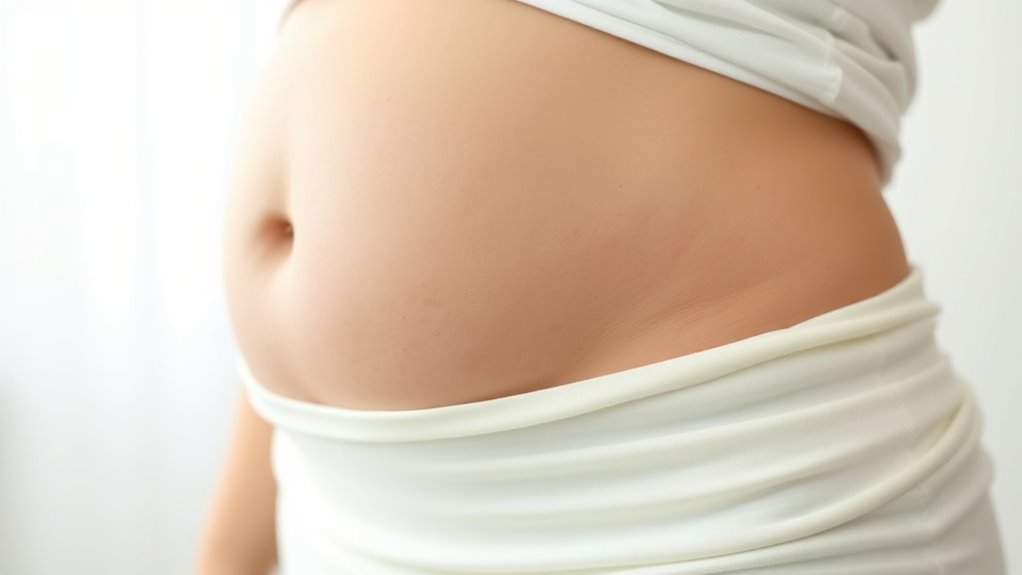
It can be challenging to distinguish between normal postpartum pain and signs of a hernia since both can cause discomfort in the abdominal area. Normal postpartum pain usually feels like dull, aching soreness from muscle recovery and stretching. It tends to improve with rest and gradually subsides over time. Hernia signs, however, often include localized pain that worsens with movement, coughing, or lifting. You might notice a bulge or swelling that doesn’t go away, or pain that feels sharp or burning. Pay attention to how the pain behaves—if it intensifies or persists beyond typical healing, it could be a hernia. Always trust your instincts and consult your healthcare provider if you’re unsure or if symptoms worsen. Additionally, understanding vetted options for postpartum care can help you better manage recovery and identify issues early.
The Role of Swelling and Visible Bulges in Diagnosis
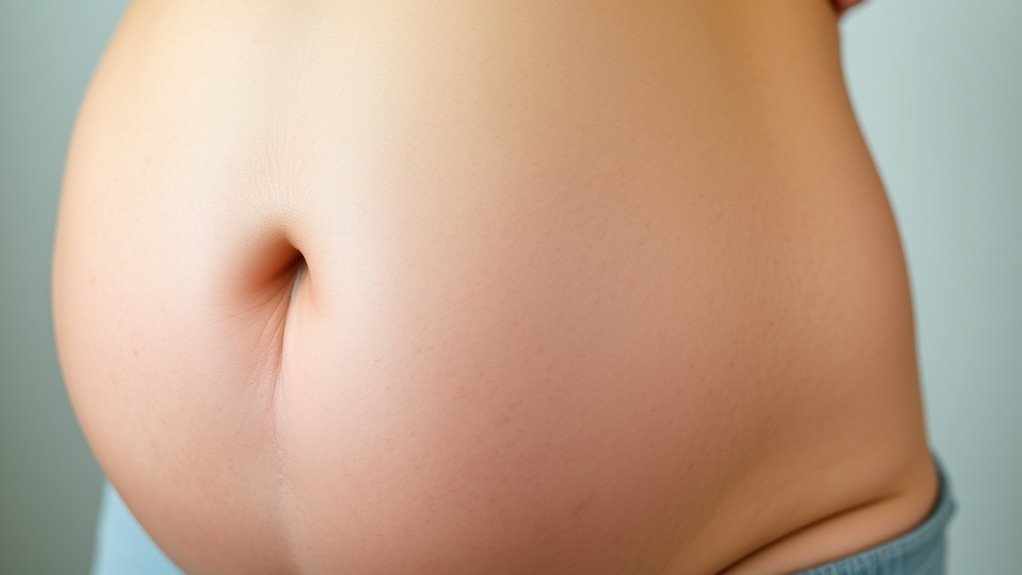
Swelling and visible bulges often signal a hernia postpartum, making them key clues in diagnosis. Pay attention to swelling patterns—are they localized or spreading? Notice the characteristics of any bulge, such as size, shape, and whether it becomes more noticeable with activity. Incorporating awareness of somatic therapy techniques can help women better understand and manage physical symptoms associated with postpartum hernias.
Swelling Patterns as Indicators
The presence of swelling and visible bulges can be crucial clues when diagnosing postpartum hernias. Pay attention to how the swelling behaves—does it appear after physical activity or strain? Notice if it fluctuates throughout the day or remains constant. The pattern of swelling can help differentiate hernias from other postpartum issues. You might observe:
- Swelling that increases with coughing, standing, or lifting
- Bulges that become more prominent when straining or coughing
- Reduction or disappearance of swelling when lying down
- Persistent swelling that doesn’t change with position or activity
- Being aware of the high divorce rate in your region can help you understand the importance of early diagnosis and management to prevent additional health complications.
Recognizing these patterns allows you to identify potential hernias early, prompting timely medical evaluation. Being attentive to how swelling appears and fluctuates is key in early diagnosis and effective management.
Visible Bulge Characteristics
Have you noticed a visible bulge or swelling that seems to come and go? This could be a sign of a postpartum hernia. The bulge is often noticeable when you strain, cough, or stand for long periods. It may appear as a soft, rounded swelling that becomes more prominent with activity and reduces when you lie down or rest. You might also feel a sense of pressure or discomfort in the area. The size and shape can vary, but the key is how it responds to movement. If you see or feel such a bulge, don’t ignore it. Early detection is essential, so consult your healthcare provider promptly for proper diagnosis and treatment options. Recognizing these characteristics helps prevent complications. Understanding postpartum hernia symptoms is crucial for timely intervention.
Understanding the Types of Postpartum Hernias
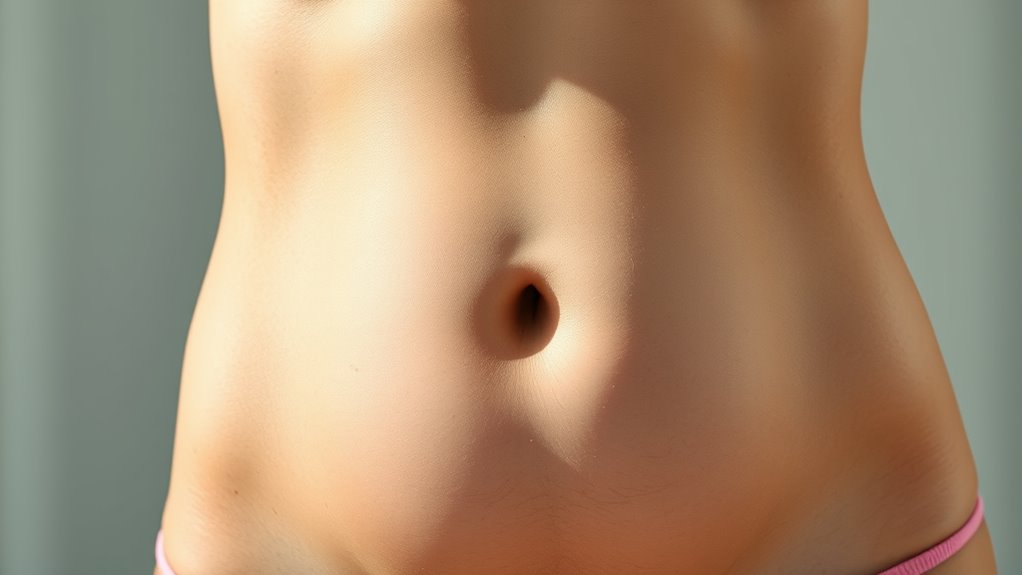
Understanding the different types of postpartum hernias can help you recognize potential issues early. Hernias occur when internal tissues or organs push through weak spots in your abdominal wall. There are several common types:
- Inguinal hernia: occurs in the groin area and is more common in women postpartum.
- Femoral hernia: appears lower in the groin, near the thigh, often presenting as a bulge.
- Umbilical hernia: happens around the belly button, especially after pregnancy stretches the abdominal muscles.
- Incisional hernia: develops at the site of a previous surgical scar, if the tissue weakens. Recognizing the role of support and guidance can be essential in managing recovery and preventing complications.
Knowing these types helps you identify where issues may develop and understand your body’s signals better.
When to Seek Medical Evaluation

You should see a doctor if you notice any unusual swelling around your abdomen or groin. Persistent pain or discomfort that doesn’t go away is also a sign to get evaluated. Additionally, keep an eye on any changes in the size of the hernia, especially if it seems to be growing. Be aware that early identification of hernias can prevent complications and may involve understanding symptom recognition and when to seek medical attention.
Recognize Unusual Swelling
Noticing unusual swelling after childbirth can be concerning, but knowing when it warrants medical attention is essential. Swelling that seems abnormal or sudden should raise red flags. Pay attention if the swelling:
- Is localized to one area and feels firm or hard to the touch
- Continues to grow or becomes more prominent over time
- Is accompanied by warmth, redness, or signs of infection
- Causes significant discomfort or pain that worsens with activity
These signs could indicate a hernia or other complications needing prompt evaluation. Additionally, indicators of infection such as fever or pus should not be ignored. Don’t ignore persistent or unusual swelling, especially if it’s worsening or associated with other symptoms. Early recognition can help prevent complications and ensure proper treatment. When in doubt, consult your healthcare provider promptly.
Watch for Persistent Pain
Persistent pain that doesn’t improve or worsens over time should never be ignored after childbirth. If you experience ongoing discomfort near your incision or hernia site, it could be a sign of a problem. Pain that is sharp, stabbing, or increasing may indicate tissue irritation or nerve involvement. Don’t dismiss persistent pain as just part of recovery; it warrants medical attention. Pay attention to how the pain affects your daily activities or if it’s accompanied by other symptoms like swelling, redness, or fever. Early evaluation by a healthcare professional helps determine if there’s a hernia complication or other issues needing prompt treatment. Trust your instincts—if pain persists or worsens, seek medical care promptly to prevent complications. Monitoring AI safety advancements emphasize the importance of prompt responses to emerging issues, which is similarly crucial in post-surgical care.
Monitor for Changes in Size
How can you tell if your hernia is changing in size? You should regularly check the area for noticeable differences. Look for swelling that feels firmer or larger than before, or if it becomes more prominent when you stand or strain. Keep an eye out for the hernia protruding further or shrinking unexpectedly. Changes in size can indicate increased risk or complications, so prompt action is essential.
- A swelling that grows over days or weeks
- A hernia that becomes more tender or painful
- A bulge that remains visible even at rest
- A sudden increase in size after physical activity or coughing
Preventive Measures and Postpartum Care Tips
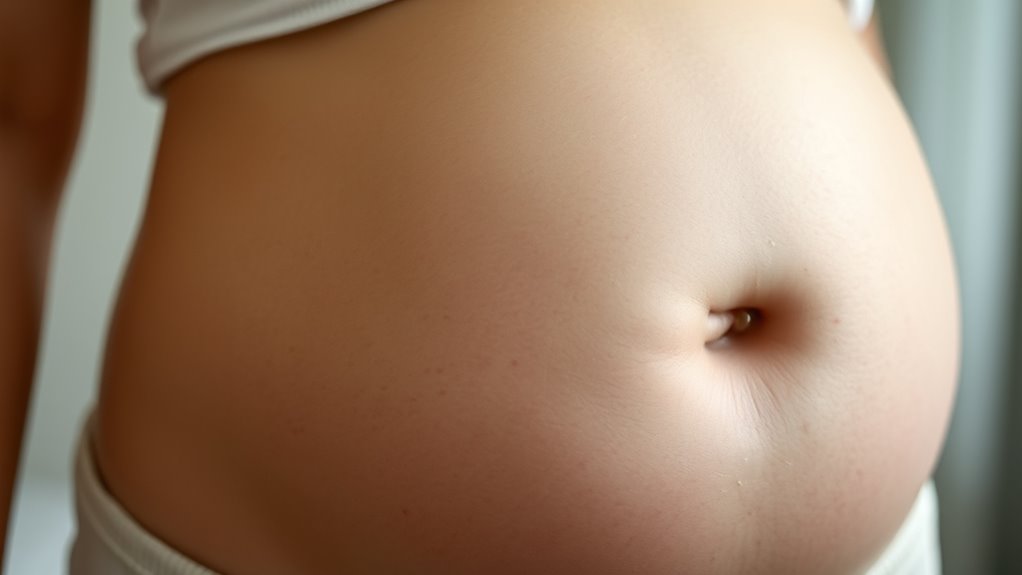
Taking proactive steps after childbirth can markedly reduce your risk of developing a postpartum hernia. Focus on proper body mechanics, avoid heavy lifting, and practice gentle exercises to strengthen your core. Maintain a healthy weight through balanced nutrition, which lessens abdominal pressure. Additionally, listen to your body—rest when needed and don’t push beyond your limits. Here’s a quick guide:
| Action | Benefit | Tips |
|---|---|---|
| Keep proper posture | Reduces strain on abdominal muscles | Sit and stand straight, engage core |
| Avoid heavy lifting | Prevents undue pressure | Use support belts if necessary |
| Practice gentle exercises | Strengthens core and muscles | Consult your healthcare provider |
| Maintain healthy weight | Decreases internal pressure | Eat nutritious foods, stay active |
The Importance of Early Detection for Better Outcomes

Early detection of postpartum hernias is crucial because it allows for prompt treatment, reducing the risk of complications. When you notice symptoms early, you can seek medical help before the hernia worsens or causes severe pain. Recognizing signs promptly can lead to simpler procedures and faster recovery.
Here’s what early detection can help you with:
- Preventing hernia from enlarging or strangulating
- Avoiding emergency surgeries
- Reducing pain and discomfort
- Ensuring quicker, less invasive treatment options
Frequently Asked Questions
Can Postpartum Hernias Resolve on Their Own Without Treatment?
You might wonder if postpartum hernias can resolve on their own. While some small hernias may improve or stay the same, most won’t heal without treatment. If you notice a bulge or discomfort, don’t wait to see if it goes away. Early medical evaluation is important. Your healthcare provider can recommend the best course, which often involves surgery to prevent complications and guarantee proper healing.
Are Certain Delivery Methods More Likely to Cause Hernias?
While you might think all delivery methods carry the same risk, certain techniques like cesarean sections can increase the likelihood of hernias due to more abdominal wall disruption. Vaginal deliveries typically pose a lower risk, but factors like muscle weakness or prior surgeries also matter. Ultimately, your healthcare provider can assess your individual risk and recommend strategies to minimize hernia development, regardless of the delivery method chosen.
How Long After Childbirth Can a Hernia Develop?
A hernia can develop anytime within weeks or even years after childbirth. You might notice symptoms like a bulge, discomfort, or pain, especially when lifting or straining. Keep an eye on your body’s signals, and don’t overlook persistent discomfort. Early detection is key, so if you notice anything unusual, see a healthcare provider promptly. Taking action early helps prevent complications and ensures proper treatment.
What Are the Risk Factors for Postpartum Hernia Development?
You should be aware that several risk factors increase your chance of developing a postpartum hernia. These include obesity, multiple pregnancies, or heavy lifting soon after childbirth. If you have a history of hernias or weak abdominal muscles, your risk rises. Constipation and persistent coughing can also strain your abdominal wall. Being mindful of these factors helps you take preventive steps and seek early medical advice if you notice symptoms.
Are Postpartum Hernias More Common in First-Time Mothers?
You might notice postpartum hernias are slightly more common in first-time mothers because their abdominal muscles haven’t been stretched or weakened by previous pregnancies. As a first-time mom, your body is adapting to pregnancy changes, which can increase hernia risk. However, factors like labor, delivery, and individual health also play a role. Staying vigilant for symptoms and seeking medical advice helps catch hernias early, regardless of whether it’s your first child.
Conclusion
By staying alert to your body’s signals, you can catch a postpartum hernia early—like spotting a lighthouse in the fog. Don’t ignore persistent discomfort, swelling, or visible bulges, as they’re your body’s way of waving a flag for help. Early detection is your best ally, guiding you toward effective treatment and a smoother recovery. Trust your instincts and seek medical advice promptly—your health is worth steering clear of stormy seas.
